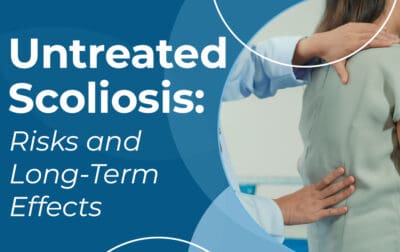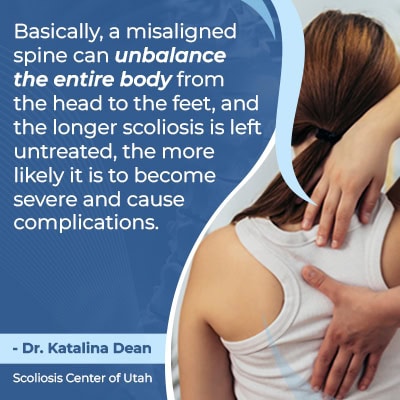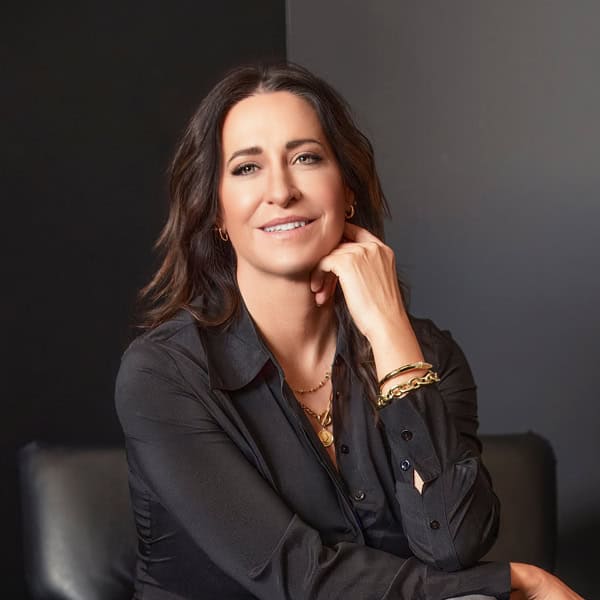Blogs
Untreated Scoliosis: Risks and Long-Term Effects
 Scoliosis is progressive, but that doesn’t mean it can’t be highly responsive to proper care. Proactive non-surgical treatment works towards preventing complications, rather than responding to them once they’ve developed and are harder to reverse.
Scoliosis is progressive, but that doesn’t mean it can’t be highly responsive to proper care. Proactive non-surgical treatment works towards preventing complications, rather than responding to them once they’ve developed and are harder to reverse.
The danger of untreated scoliosis is that it can continue to get worse. The more scoliosis progresses, the more difficult it can be to treat, the more affected the spine and body are, and the more likely it is that surgical treatment will be recommended in the future.
To better understand the importance of treatment, let’s talk about how scoliosis progresses and what it means for potential treatment efficacy.
Untreated Scoliosis: Increasing Effects
A healthy spine has its natural curves in place, and this means its vertebrae are aligned for more strength, flexibility, balance, and stability.
Scoliosis causes a portion of the spine to bend to the side unnaturally, causing lateral movement, and disrupting the biomechanics of the entire spine; as a 3-dimensional condition, scoliosis also causes the spine to rotate (twist) unnaturally.
As a progressive spinal condition, the condition’s nature is to get worse, and while we don’t always understand the initial catalyst behind scoliosis developing, we know growth triggers progression.
Growth spurts are uncontrollable, so the danger of leaving scoliosis untreated in children is rapid progression triggered by the unpredictable and intense growth spurts of puberty.
As the effects of scoliosis become more pronounced, they are also becoming more difficult to improve and/or reverse; mild scoliosis is simpler to treat because the curves are smaller, effects are subtle, and significant progression hasn’t yet occurred.
While no treatment results can be guaranteed, if scoliosis is left untreated, complications can develop, many of which can be avoided simply by starting treatment early when conditions are at their most responsive.
Potential Complications of Untreated Scoliosis
The most common type of scoliosis is adolescent idiopathic scoliosis, and this condition type is the most risky to leave untreated because the growth spurts of puberty can make it progress quickly.
 If scoliosis is left untreated, the curve size is likely to increase, along with the condition’s effects, which are becoming more difficult to reverse, and the spine is also becoming more rigid and less responsive to a variety of treatments.
If scoliosis is left untreated, the curve size is likely to increase, along with the condition’s effects, which are becoming more difficult to reverse, and the spine is also becoming more rigid and less responsive to a variety of treatments.
Untreated scoliosis can become severe and/or very severe, and severe cases, and/or atypical cases, are associated with certain complications, and surgical recommendations.
Breathing Problems
Lung impairment is associated with severe and very-severe cases of thoracic scoliosis; the thoracic spine is the only spinal section attached to the rib cage, and if the thoracic spine bends and twists unnaturally, it’s also pulling on the rib cage, disrupting its position.
If the rib cage’s change in position has resulted in compression of the lungs, this can make it difficult to catch one’s breath, to breathe deeply, and can cause a number of breathing problems, particularly for athletes.
Cardiovascular Issues
Cardiovascular issues can also develop from the heart being compressed, and this is particularly common with atypical cases of scoliosis, such as levoscoliosis where the curve bends to the left, towards the heart.
Pulmonary function can be affected when postural changes mean the heart is being compressed, as is also more common in very severe cases and/or atypical cases of levoscoliosis.
Digestive Issues and Headaches
Digestive issues are also common as contortion and compression can affect the stomach, organs, and muscles involved in digestion.
Headaches and migraines are additional potential complications of scoliosis caused by disrupting the flow of cerebrospinal fluid (CSF) between the spine and in and around the brain.
Chronic Back Pain
Not all cases of scoliosis involve chronic pain; in fact, although more commonly diagnosed in children, it’s adult scoliosis that’s more associated with back pain, and this is because scoliosis becomes a compressive condition when growth stops.
A child’s spine is constantly being lengthened during growth, and this counteracts the compressive force of the scoliotic curve: a barrier to early detection of childhood scoliosis.
In many cases of idiopathic scoliosis in adults, these patients didn’t develop scoliosis fresh in adulthood; they had it throughout their adolescence, but were unaware, and during growth, the condition progressed, becoming noticeable and painful once growth stopped, leading to a late diagnosis in adulthood.
If left untreated, the spine is going to become more out of balance and more unstable, and as adults age, spinal degeneration comes into effect, and this is when adult scoliosis can also progress quickly and cause complications.
But before scoliosis can be treated, it has to be detected and diagnosed, and as mentioned, early detection isn’t always easy.
Diagnosing Scoliosis Early
Diagnosing scoliosis early means while it’s still mild, before significant progression has already occurred, and while it can seem like an unnaturally-bent and twisted spine would be easy to detect, its effects can be subtle.
Not only does scoliosis affect all ages, there are also different condition types, and scoliosis ranges widely in severity from mild scoliosis to moderate and severe scoliosis.
The more severe scoliosis is, the more overt its effects are and the more noticeable the condition is; when mild, conditions can be asymptomatic, and it’s not uncommon that scoliosis isn’t overly noticeable until enough progression has occurred to increase its effects and/or conditions become painful.
Scoliosis Correction and Chiropractic Treatment Options
When scoliosis is left untreated, it’s likely to become more severe, and this means its effects are going to be overt, and surgery can be recommended.
While spinal fusion has been used for years to stop a scoliotic spinal curvature from progressing, many cases of scoliosis, particularly those that are diagnosed early, will also respond to nonsurgical treatment that’s less invasive and healthier for the spine.
Spinal conditions that expose the spine and its surrounding muscles and nerves to uneven forces and pressure are capable of affecting the entire body; it’s not just posture that can be disrupted, but also movement and nerve function.
The spine is at the center of human anatomy, and if it’s unbalanced, those uneven forces are felt throughout the body in uneven hips, uneven shoulders, one shoulder blade protruding excessively, and more.
 Basically, a misaligned spine can unbalance the entire body from the head to the feet, and the longer scoliosis is left untreated, the more likely it is to become severe and cause complications.
Basically, a misaligned spine can unbalance the entire body from the head to the feet, and the longer scoliosis is left untreated, the more likely it is to become severe and cause complications.
As scoliosis causes the spine to bend and twist unnaturally, its vertebrae are misaligned, and this means the body is out of balance, and restoring the spine’s balance and stability is key to spinal health, strength, and quality of life.
Chiropractic BioPhysics®
Chiropractic can help with pain relief by improving the spine’s flexibility and addressing areas where the spine isn’t aligned, as in scoliosis.
Being certified in Chiropractic BioPhysics® means patients of the Scoliosis Center of Utah benefit from a highly specialised and integrative approach that combines the power of physiology, biology, anatomy, physics, geometry.
CBP is the most comprehensive branch of chiropractic medicine that has the goal of identifying the underlying cause of mobility issues, back pain, and spinal issues such as misalignment.
A series of precise manual adjustments has the goal of realigning the spine by manipulating the position of the vertebral bodies that have shifted the farthest out of alignment, and when successful, this restores balance to the spine and body.
Scoliosis Specific Exercises
ScoliBalance® therapy applies corrective exercises that can help restore posture and improve the spine’s support and stability through improving the spine’s surrounding muscle strength and balance.
ScoliCorrection exercises are taught to patients so they can sustain postural changes and a healthier spinal alignment.
Another key facet of non surgical interventions includes corrective bracing.
ScoliBrace®
The ScoliBrace® is an ultra-corrective scoliosis brace that can be particularly effective on growing spines that are more flexible than adult spines, and tend to be more malleable and responsive.
An abnormal curvature of the spine doesn’t always require surgery, and when it comes to treating adolescent idiopathic scoliosis, the condition’s most common type, the 3-dimensional corrective potential of the ScoliBrace® is a powerful non surgical treatment option.
As part of the Center’s approach, bracing, along with every aspect of a treatment plan, is fully individualized to address the specifics of each patient and their condition.
State of the art 3-dimensional digital software and scanning technology is applied for a series of images and curve measurements so braces are as specific to each patient as possible; this makes them more effective, comfortable, and helps with compliance.
The ScoliBrace® is part of a comprehensive program that combines the power of multiple different types of treatment including chiropractic care, corrective bracing, and corrective exercises.
Conclusion
There are different potential results to leaving scoliosis untreated, and in addition to developing complications that can include breathing problems, digestive issues, and chronic back pain, a primary benefit to starting treatment early is that it can help patients avoid the potential complications of surgery.
It’s not just the risks directly associated with the procedure of spinal fusion itself that patients need to consider, but also the potential long-term complications of living with a fused spine, some of which are a loss in spinal flexibility, an increase in back pain, and a weaker spine.
So when it comes time to seek treatment for scoliosis, don’t hesitate to book an appointment to find out if you, or a loved one, is a good candidate for the Scoliosis Center of Utah’s evidence-based non surgical approach.

Dr. Katalina Dean
Dr. Katalina Dean is the founder and clinical director of Scoliosis Center of Utah, in Midvale, UT. Her team specializes in posture correction, spinal rehabilitation, and non-invasive scoliosis care and bracing.
Call Today
Do You Qualify for Care?
Schedule an Appointment Below
